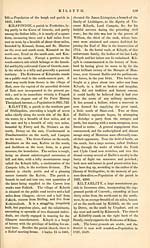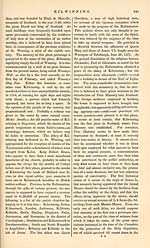Gazetteer of Scotland > Volume 2
(156) Page 640 - KIL
Download files
Complete book:
Individual page:
Thumbnail gallery: Grid view | List view

640
KILWINNING.
KILTEARN, a parish in Ross-shire, in
the district of Easter Ross, lying on the north
side of the Firth of Cromarty, and extending
ahout six miles in length. The breadth is va-
rious ; that part which is well cultivated is
ahout two miles broad from the sea-shore to
the foot of the hilly ground on the north, but
there are several grazings and Highland pos-
sessions at the distance of five, ten, and even
fifteen miles from the sea. It is bounded by
Alness on the east, Contin and Lochbroom on
the west, and by Dingwall and Fodderty on
the south. The Highland district of this
parish is, for the most part, wild and unculti-
vated, consisting of high mountains separated
from each other by rapid rivulets, and exten-
sive tracts of moor and mossy ground. The
low district of the parish, which inclines gently
from the foot of the hills towards the sea, is of
a very rich and beautiful nature, exhibiting
well cultivated fields, plantations, and pleasure
and garden grounds. The chief river in the
parish is the Skiach, which falls into the Cro-
marty Firth at Kiltearn. On its left bank
stands the small village of Drummond. — Po-
pulation in 1821, 1656.
KILVICEUEN, a parish in the island of
Mull, now incorporated with Kilfinichen. —
See Kilfinichen.
KILWINNING, a parish in the district of
Cunningham, Ayrshire, extending about nine
miles at the utmost each way, and bounded on
the north by Dairy, on the east by Dunlop and
Stewarton, on the south by Irvine, and on tbe
west by Stevenston, which divides it from the
coast of the Firth of Clyde. The parish lies
upon a gentle inclination towards the east,
with slight intermediate undulations, the tops
of which are generally covered by beautiful
plantations. Like the rest of this fertile dis-
trict, it is in a state of the highest cultivation,
and is everywhere well enclosed. It is water-
ed by the Garnock water, and by the Lugton,
a tributary of that rivulet. There are several
large collieries in the parish, and freestone
and limestone are found in great abundance.
A great part of the parish is composed of the
barony of Eglinton, which is one of the
most beautiful pieces of cultivated territory in
Scotland, as its seat, Eglinton Castle, is one
•of the most elegant and distinguished mansions.
For the early history of this family, see Eg-
linton Castle. This spot has been the prin-
cipal seat of the family for between four and
live hundred years, and has conferred upon it
its title. The ancient family house was re-
built since the commencement of the present
century, in the castellated style, and the result
is well entitled to the description above bestow-
ed upon it. It is surrounded by about two
thousand Scotch acres of park and pleasure
ground, laid out in the very best taste. The
first efforts for the decoration of this spot
were made by Alexander Earl of Eglinton,
a most liberal and patriotic young nobleman,
who unfortunately was shot in 1780, ere his
plans for the good of his country had been half
completed. Ayrshire, as already mentioned,
owes much of its present advancement in
agriculture to his exertions ; and it ought here
to be mentioned that a great part of the culti-
vated and wooded beauty of Kilwinning is also
owing to him. The statist of the parish very
properly characterises him in the well-known
lilies: —
Cui pudor et jnstitiae soror
Incorrupta fides, nudaque Veritas
Quando ullum inveniet parem ?
Multis ille bonis flebilis occidit.
Kilwinning, an ancient and now a consider-
able and thriving town in the above parish, si-
tuated on a rising ground about two miles from
the sea, three miles north-north-west of Irvine,
four south of Dairy, and four north-east of
Saltcoats. Kilwinning depends chiefly on the
weaving and manufacture of gauzes, muslins,
&c- for the Glasgow and Paisley markets.
With the contiguous village of Byres on the
west, its inhabitants amounted in the year
1821 to 1934. Two fairs are held in the town
annually. Besides the parish church, there are
two dissenting meeting-houses- This curious
old-fashioned little town stretches westward
from the right bank of the Garnock, and con-
sists chiefly of one street and some bye-lanes,
together with a few rows of modern houses.
It is approached through long umbrageous
paths, skirted by beautiful fields, and the tra-
veller, on entering from the east, is reminded
of the ancient sacred character of the place
by ascending the Cross Hill, an eminence
where, in former times, the monks of Kilwin-
ning Abbey had established the revered ensign
of Christianity, to receive the preliminary
adoration of the pilgrims who flocked to visit
their shrines. The Abbey of Kilwinning,
from which the town has evidently taken its .
origin, was one of the most wealthy and im-
portant institutions of that kind in the king-
KILWINNING.
KILTEARN, a parish in Ross-shire, in
the district of Easter Ross, lying on the north
side of the Firth of Cromarty, and extending
ahout six miles in length. The breadth is va-
rious ; that part which is well cultivated is
ahout two miles broad from the sea-shore to
the foot of the hilly ground on the north, but
there are several grazings and Highland pos-
sessions at the distance of five, ten, and even
fifteen miles from the sea. It is bounded by
Alness on the east, Contin and Lochbroom on
the west, and by Dingwall and Fodderty on
the south. The Highland district of this
parish is, for the most part, wild and unculti-
vated, consisting of high mountains separated
from each other by rapid rivulets, and exten-
sive tracts of moor and mossy ground. The
low district of the parish, which inclines gently
from the foot of the hills towards the sea, is of
a very rich and beautiful nature, exhibiting
well cultivated fields, plantations, and pleasure
and garden grounds. The chief river in the
parish is the Skiach, which falls into the Cro-
marty Firth at Kiltearn. On its left bank
stands the small village of Drummond. — Po-
pulation in 1821, 1656.
KILVICEUEN, a parish in the island of
Mull, now incorporated with Kilfinichen. —
See Kilfinichen.
KILWINNING, a parish in the district of
Cunningham, Ayrshire, extending about nine
miles at the utmost each way, and bounded on
the north by Dairy, on the east by Dunlop and
Stewarton, on the south by Irvine, and on tbe
west by Stevenston, which divides it from the
coast of the Firth of Clyde. The parish lies
upon a gentle inclination towards the east,
with slight intermediate undulations, the tops
of which are generally covered by beautiful
plantations. Like the rest of this fertile dis-
trict, it is in a state of the highest cultivation,
and is everywhere well enclosed. It is water-
ed by the Garnock water, and by the Lugton,
a tributary of that rivulet. There are several
large collieries in the parish, and freestone
and limestone are found in great abundance.
A great part of the parish is composed of the
barony of Eglinton, which is one of the
most beautiful pieces of cultivated territory in
Scotland, as its seat, Eglinton Castle, is one
•of the most elegant and distinguished mansions.
For the early history of this family, see Eg-
linton Castle. This spot has been the prin-
cipal seat of the family for between four and
live hundred years, and has conferred upon it
its title. The ancient family house was re-
built since the commencement of the present
century, in the castellated style, and the result
is well entitled to the description above bestow-
ed upon it. It is surrounded by about two
thousand Scotch acres of park and pleasure
ground, laid out in the very best taste. The
first efforts for the decoration of this spot
were made by Alexander Earl of Eglinton,
a most liberal and patriotic young nobleman,
who unfortunately was shot in 1780, ere his
plans for the good of his country had been half
completed. Ayrshire, as already mentioned,
owes much of its present advancement in
agriculture to his exertions ; and it ought here
to be mentioned that a great part of the culti-
vated and wooded beauty of Kilwinning is also
owing to him. The statist of the parish very
properly characterises him in the well-known
lilies: —
Cui pudor et jnstitiae soror
Incorrupta fides, nudaque Veritas
Quando ullum inveniet parem ?
Multis ille bonis flebilis occidit.
Kilwinning, an ancient and now a consider-
able and thriving town in the above parish, si-
tuated on a rising ground about two miles from
the sea, three miles north-north-west of Irvine,
four south of Dairy, and four north-east of
Saltcoats. Kilwinning depends chiefly on the
weaving and manufacture of gauzes, muslins,
&c- for the Glasgow and Paisley markets.
With the contiguous village of Byres on the
west, its inhabitants amounted in the year
1821 to 1934. Two fairs are held in the town
annually. Besides the parish church, there are
two dissenting meeting-houses- This curious
old-fashioned little town stretches westward
from the right bank of the Garnock, and con-
sists chiefly of one street and some bye-lanes,
together with a few rows of modern houses.
It is approached through long umbrageous
paths, skirted by beautiful fields, and the tra-
veller, on entering from the east, is reminded
of the ancient sacred character of the place
by ascending the Cross Hill, an eminence
where, in former times, the monks of Kilwin-
ning Abbey had established the revered ensign
of Christianity, to receive the preliminary
adoration of the pilgrims who flocked to visit
their shrines. The Abbey of Kilwinning,
from which the town has evidently taken its .
origin, was one of the most wealthy and im-
portant institutions of that kind in the king-
Set display mode to: Large image | Transcription
Images and transcriptions on this page, including medium image downloads, may be used under the Creative Commons Attribution 4.0 International Licence unless otherwise stated. ![]()
| Gazetteers of Scotland, 1803-1901 > Gazetteer of Scotland > Volume 2 > (156) Page 640 - KIL |
|---|
| Permanent URL | https://digital.nls.uk/97432694 |
|---|
| Description | Volume II: Glenbanchor to Zetland. |
|---|---|
| Attribution and copyright: |
|
| Description | By Robert Chambers and William Chambers. Glasgow: Blackie & Son, 1838. 2 volumes. |
|---|---|
| Shelfmark | NF.1461.g.7 |
| Additional NLS resources: | |

